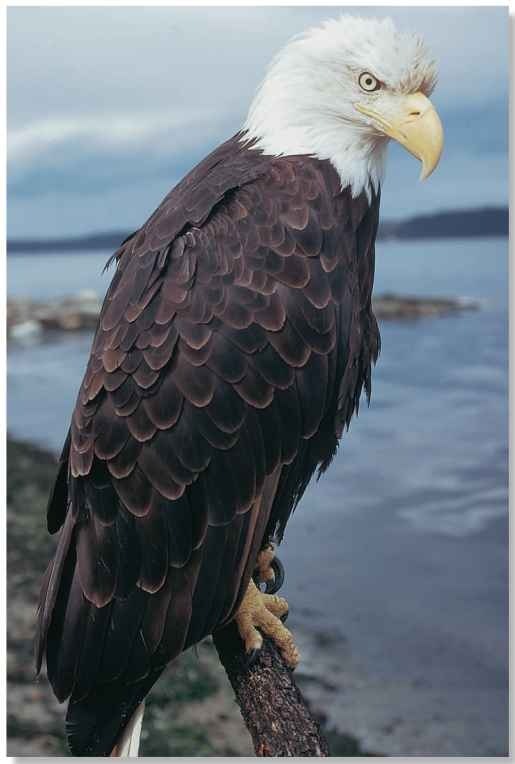ORDER
Falconiformes
FAMILY
Accipitridae
GENUS & SPECIES
KEY FEATURES
• Feet are equipped with spiny scales on the soles of the toes and sharp talons for gripping slippery fish
• Has been the national bird of the
U.S. since 1782 — ; symbolizing freedom, power and majesty
“Bald” refers not to the white head, but to f the piebald (black-and-white) adult plumage
WHERE IN THE WORLD?
Widely but thinly distributed over the coastlines and inland | waterways of Canada, the U.S. and northwest Mexico; range extends from the Arctic tundra to the subtropic mangroves

Lifecycle
A commanding presence in North American skies, the bald eagle patrols waterways and coasts, looking for the opportunity to swoop and snatch unwary fish and waterbirds.
HABITAT
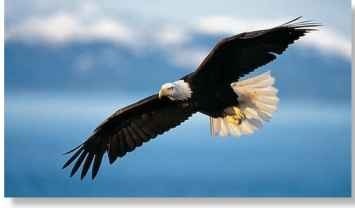
A Sky master The bald eagle soars, usually above water, on broad, 7.9′ wings.
The bald eagle is found in a range of habitats from rugged, Arctic coasts bordered by extensive coniferous forests to inland freshwater lakes and
rivers. In southern parts of the U.S., such as Florida, it is quite at home in cypress swamps and mangroves; it even inhabits parts of the dry hot deserts of the Baja peninsula in northern Mexico.
The bald eagle can often be seen sitting near the top of a tall tree at the water’s edge, which provides a good lookout while waiting for fish, or any other prey in the vicinity, to come into view.
nland-nesting eagles migrate southward in winter; and some of these migrant birds spend the non-breeding season in arid, open country far from water It is in these surroundings that the bald eagle turns its attention to a wider range of prey
CONSERVATION
Persecution and pesticides such as DDT have taken a toll on the bald eagle. From 1917 to 1945 and from 1949 to 1953, bounty hunters in Alaska shot an estimated 140,000 birds. Use of DDT in the 1960s and 1970s resulted in a 50-100% loss of breeding pairs in some areas. However, during the 1990s bald eagles have shown significant signs of recovery.
FOOD & HUNTING
From a prominent perch that overlooks water, the bald eagle scans the surface for fish. Once prey is located, the eagle flies out toward it, dropping down in a shallow glide. At the last moment it throws its feet down and forward to grab the fish just beneath the water. Hooking the fish into the air, the eagle carries it to a perch.
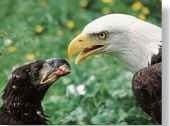
A Full-time job Feeding hungry young is very demanding for adult eagles.
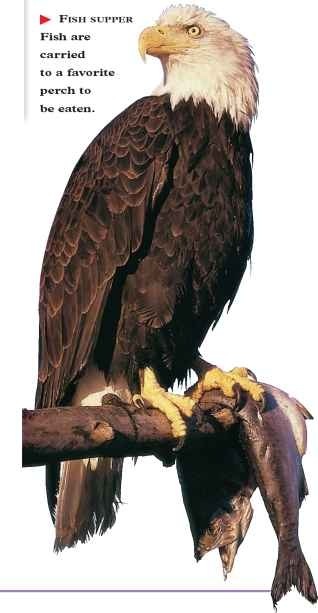
In Alaska during the autumn, when salmon swim upstream to spawn and die, bald eagles gather in great numbers to feed on exhausted and dying fish. As many as 2,000 eagles have been counted; some wade through fast-flowing waters for weakened salmon.
Although specialized for catching fish, the bald eagle hunts a range of prey (seabirds, waterfowl, mammals and reptiles). In winter when many birds move south from their breeding grounds, carrion and even scraps become mportant parts of the eagle’s diet.
BREEDING
Depending on the locality, the eagle chooses from a variety of sites for its nest— a tree, on the ground or on a cliff.The same nest is reused for many years and may eventually become huge. One nest in Florida measured 30′ across and 20′ deep, and weighed about 4,400 lbs. Several pairs may nest in a relatively small area, occupying territories as small as 2,400 yds.
The eggs, normally two, are laid several days apart. Incubation begins when the first egg is laid and the chicks hatch at different times.The first chick will be fed by the parents for several days before its sibling hatches and will, therefore, have a significant size and weight advantage over it. Should the parents be unable to bring sufficient food for both chicks, the older chick bullies the younger and weaker one until it dies of starvation.This behavior ensures that in years when food supplies run short, the older chick, at least, can be raised successfully.
LOVE IS IN THE AIR
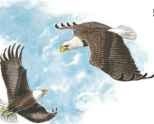
1 Round and round…
Courtship is an elaborate aerial display that begins with both birds flying leisurely in circles, the male above the female.

2 Mock attack…
Suddenly, the male swoops down toward his mate. Moments before contact, she turns upside down and thrusts her feet upward.
BEHAVIOR
As common with most raptors (birds of prey), the female bald eagle is larger than the male (known as reversed sexual dimorphism).The female needs to be large and strong so that she is able to defend herself against aggressive males, especially with young to look after The size difference between sexes also reduces competition for food, as the female is able to target prey that is too large or strong for the male to cope with.
Sometimes the bald eagle turns to piracy. It frequently intimidates and harasses the osprey, an exclusively fish-eating raptor found in a similar range. The ospreys are often forced to surrender their catches.
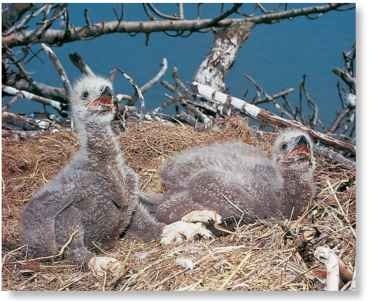

3 United we fall…
With talons locked together, the two birds tumble toward the ground, as if out of control. But at the very last instant…
4 New bond
the birds break free. Their bond confirmed or renewed, they then temporarily part, flying off in different directions.
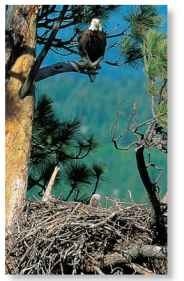
► Keeping watch A female watches over her nest. She may be 30% heavier than her mate.
Bald eagles hunt young sea otters by listening for the noises they make while feeding in kelp beds.
By fitting birds with radio transmitters, researchers show that northerly nesting bald eagles may cover 1,200 miles when migrating to the south for winter.
Profile
Bald Eagle
A powerful bill and specialized feet are essential tools in the armory of this imposing, fish-eating bird of prey.
Supraorbital ridges
These bony extensions of the skull overhang the eyes and help protect them from injury when the eagle is catching and handling prey.They also shield the eyes, like sun visors, reducing glare.
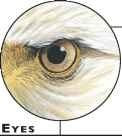
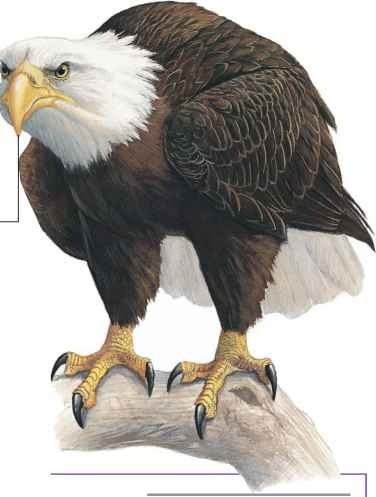
The eagle’s ability to see detail at a distance is extraordinary. Its eyesight is 4-8 times sharper than a human’s.The eyes are fixed in their sockets, so the eagle has to turn its whole head to look around.
Bill
As with all sea eagles, the bill is large, heavily built and strongly hooked. It’s capable of tearing flesh from tough carrion into small, bite-sized pieces.
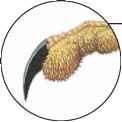
Spicules
The soles of the toes are covered by special scales with spiny projections, called sp/cu/es.Together with the sharp talons, these help grip slippery fish.
CREATURE COMPARISONS
Immature bald eagles are brown and look like other species of large eagle.The similarly sized golden eagle, Aquila chrysaetos, also has brown plummage. It can be found throughout the nontropical zones of the northern hemisphere, occupying almost the same range as the bald eagle in
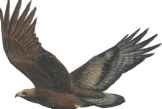
Adult golden eagle
North America. Both species soar on long, broad wings with characteristic splayed “fingertips” (primary flight feathers).
Living in remote, rocky mountainous areas, the golden eagle feeds mainly on rodents, rabbits and hares.
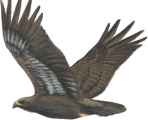
Immature bald eagle
| VITAL | |
| STATISTICS | |
| Weight | 6.6-13.9 lbs. |
| f Length | 30.4-36.4″ |
| 1′Wingspan | 5.5-8′ |
| ‘Sexual Maturity | 4 years |
| 1 Breeding Season | October-April in south, April-August in north | | |
| ‘ Number of ‘ Eggs Incubation Period |
1-3; usually 2; rarely 4 About 35 days |
| Fledging Period | 70-92 days |
| i Breeding Interval | 1 year |
| ! Typical Diet | Mainly fish and seabirds |
| ; Lifespan | 47 years in captivity; 25 years in wild |
RELATED SPECIES
• The bald eagle is one of ten species of sea eagle found worldwide, except South America. Steller’s sea eagle, Haliaeetus pelagicus, has a massive bill for feeding on salmon and is found along coasts in east Asia, from Siberia to Japan. The white-tailed sea eagle, H. albicilla,is Europe’s largest eagle species. Its range has been greatly reduced by habitat destruction.
